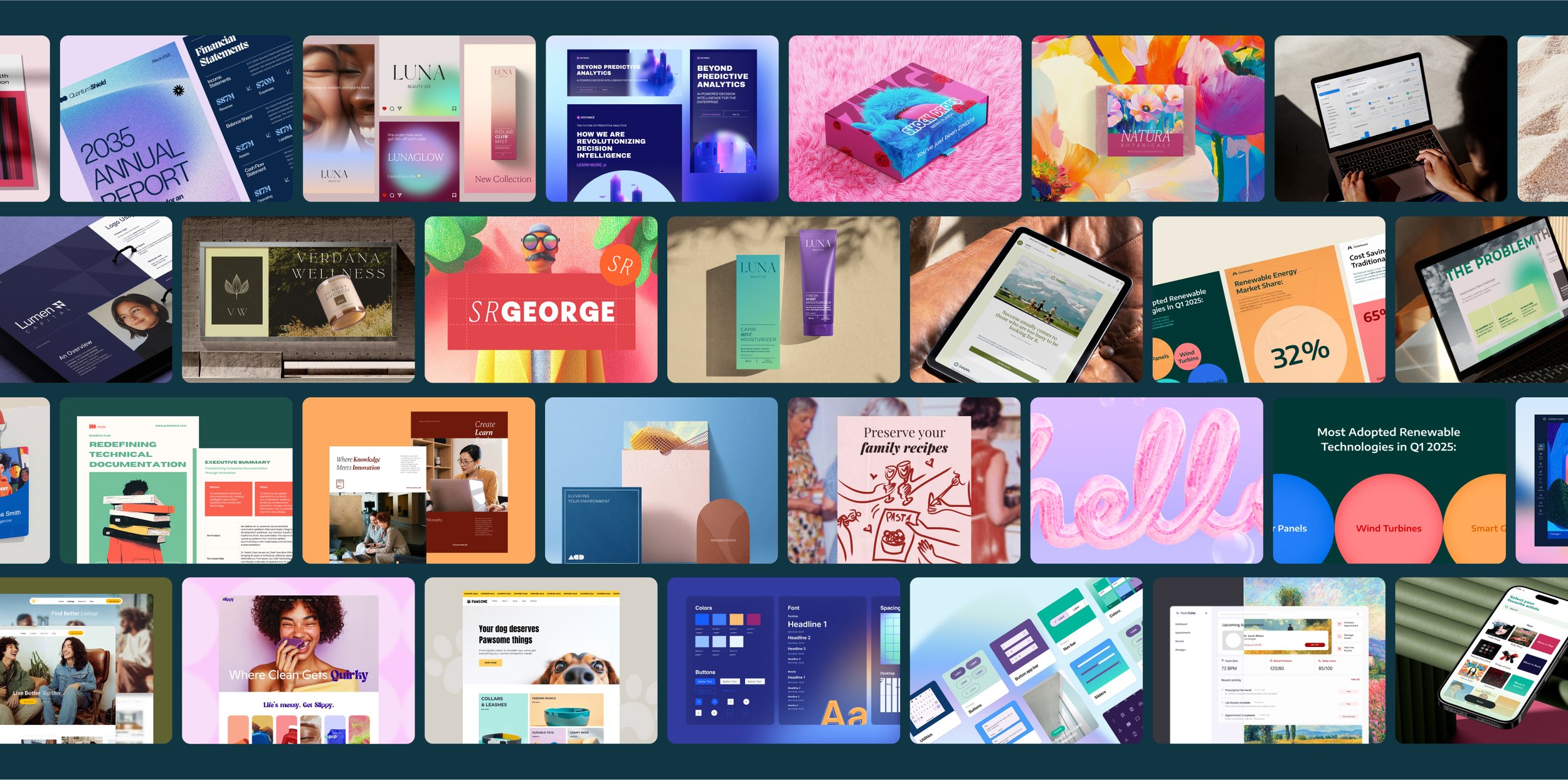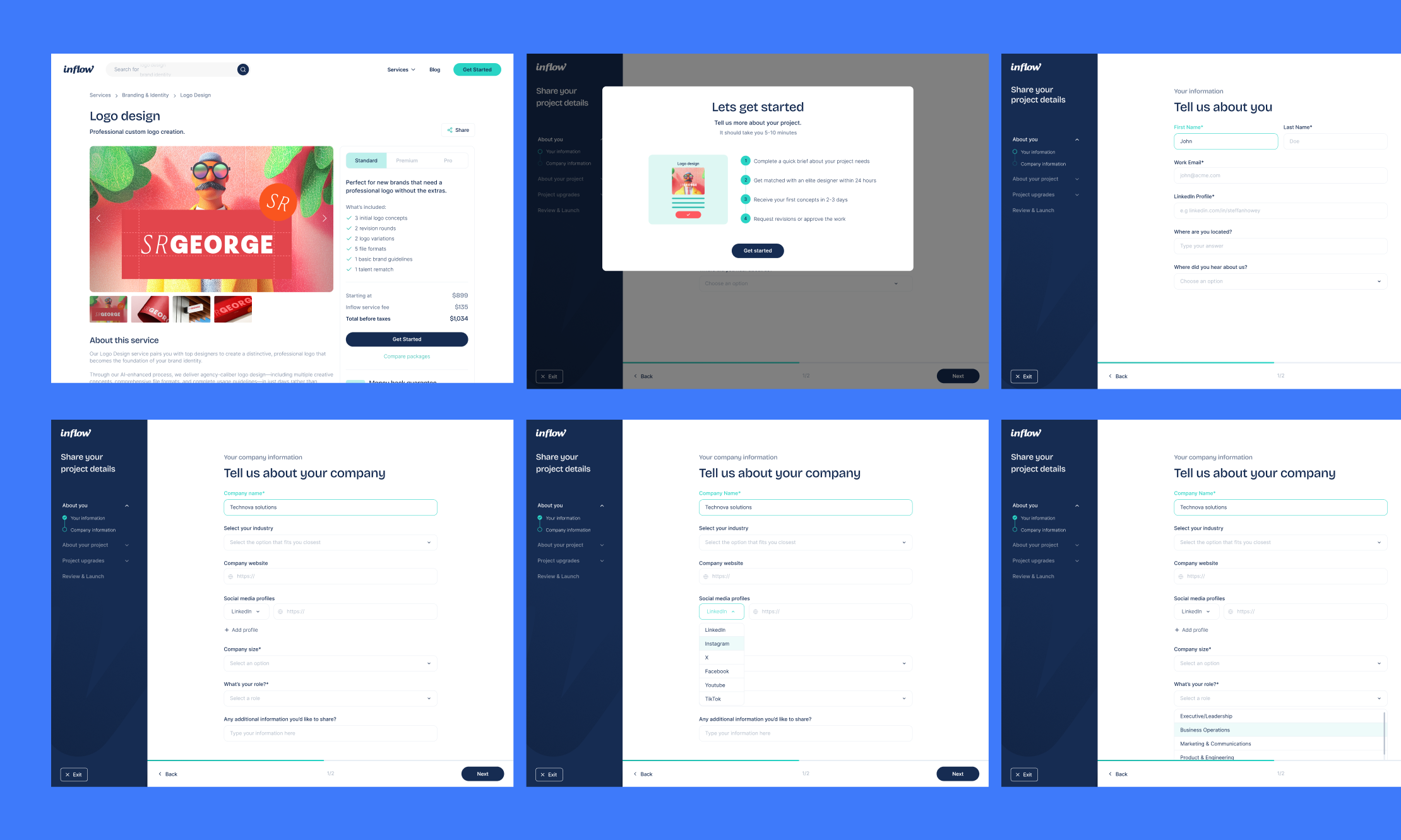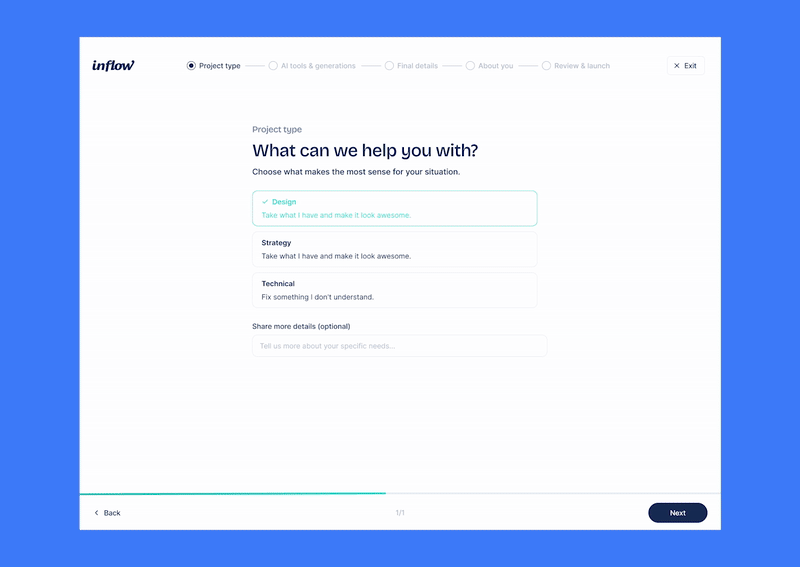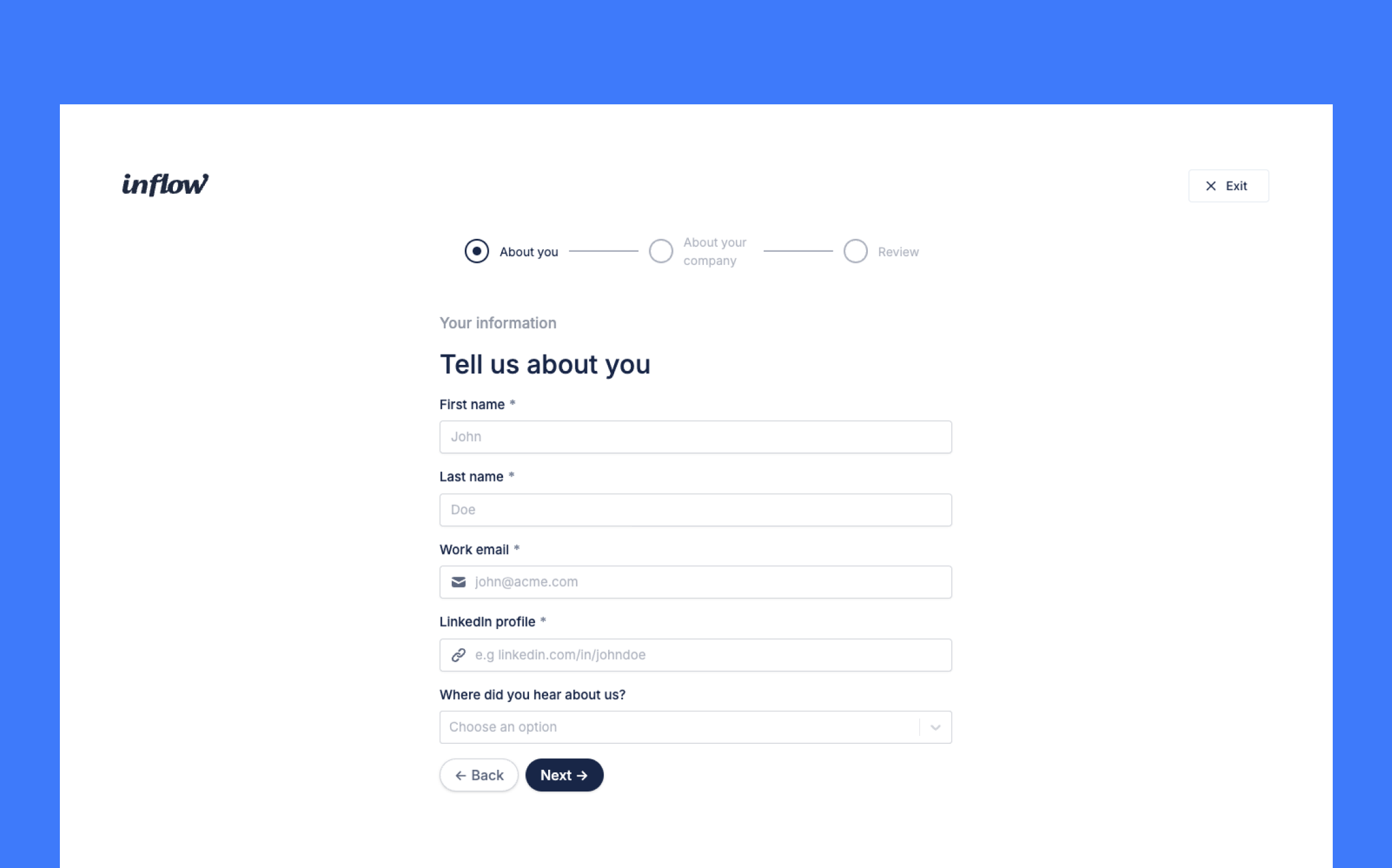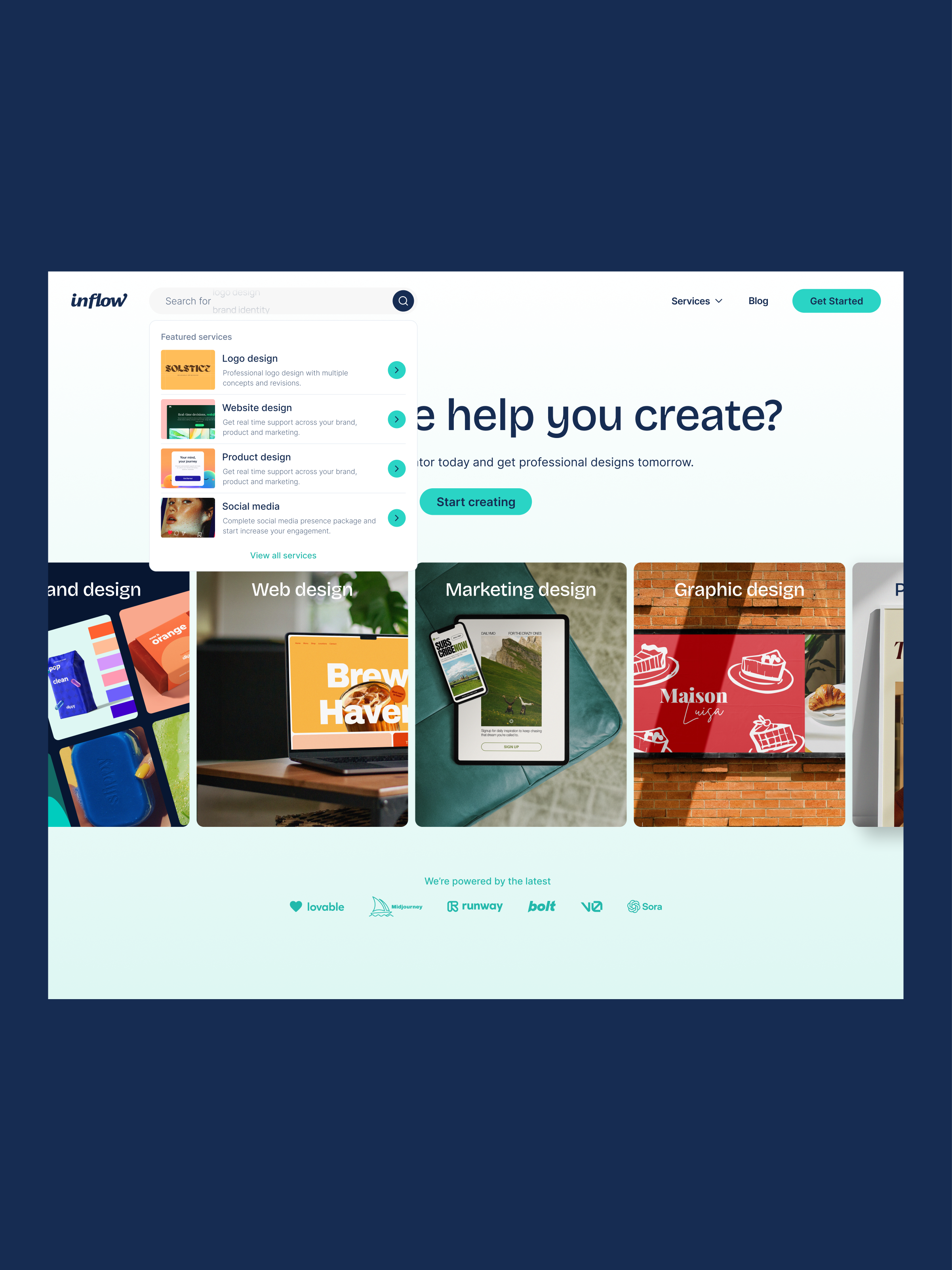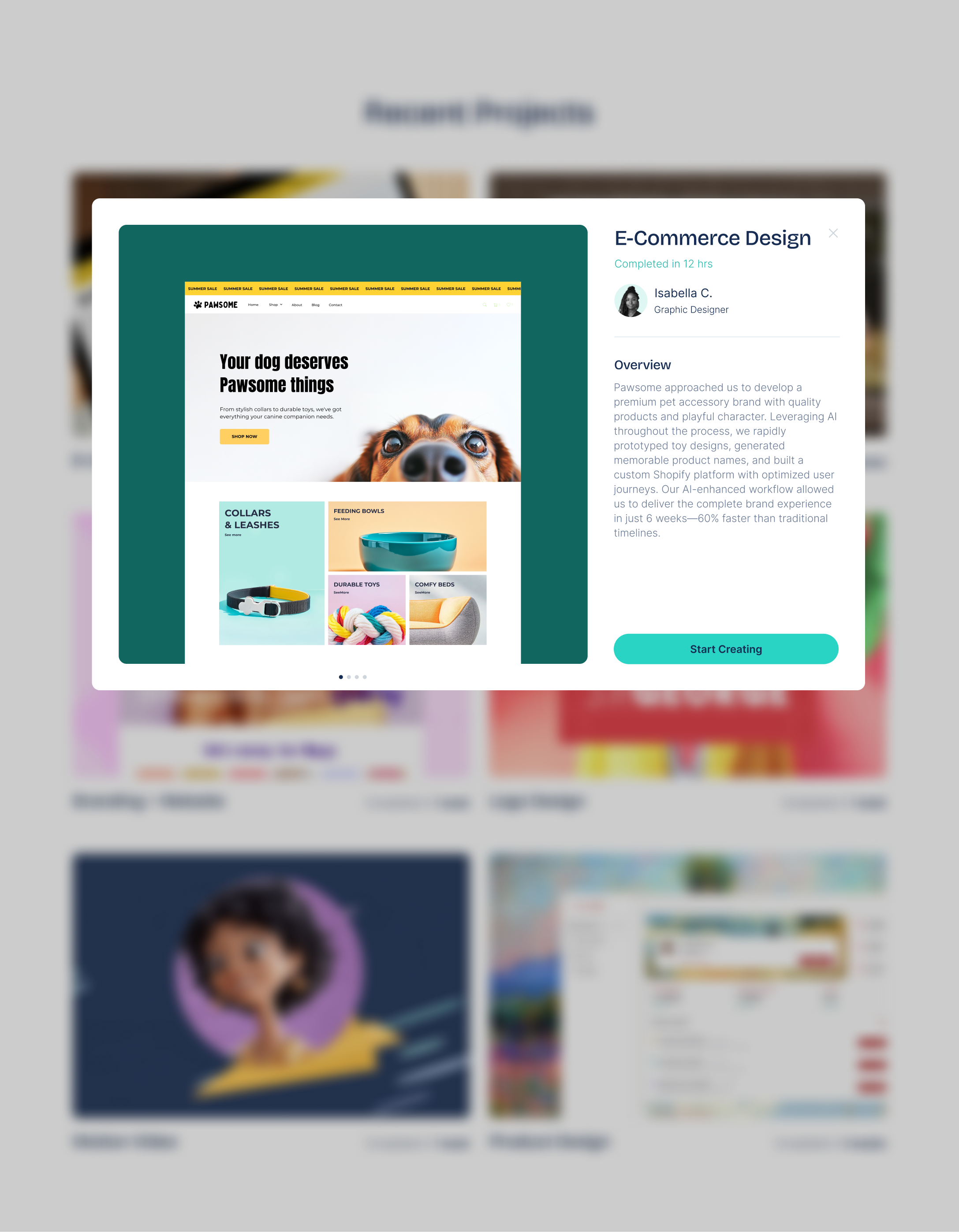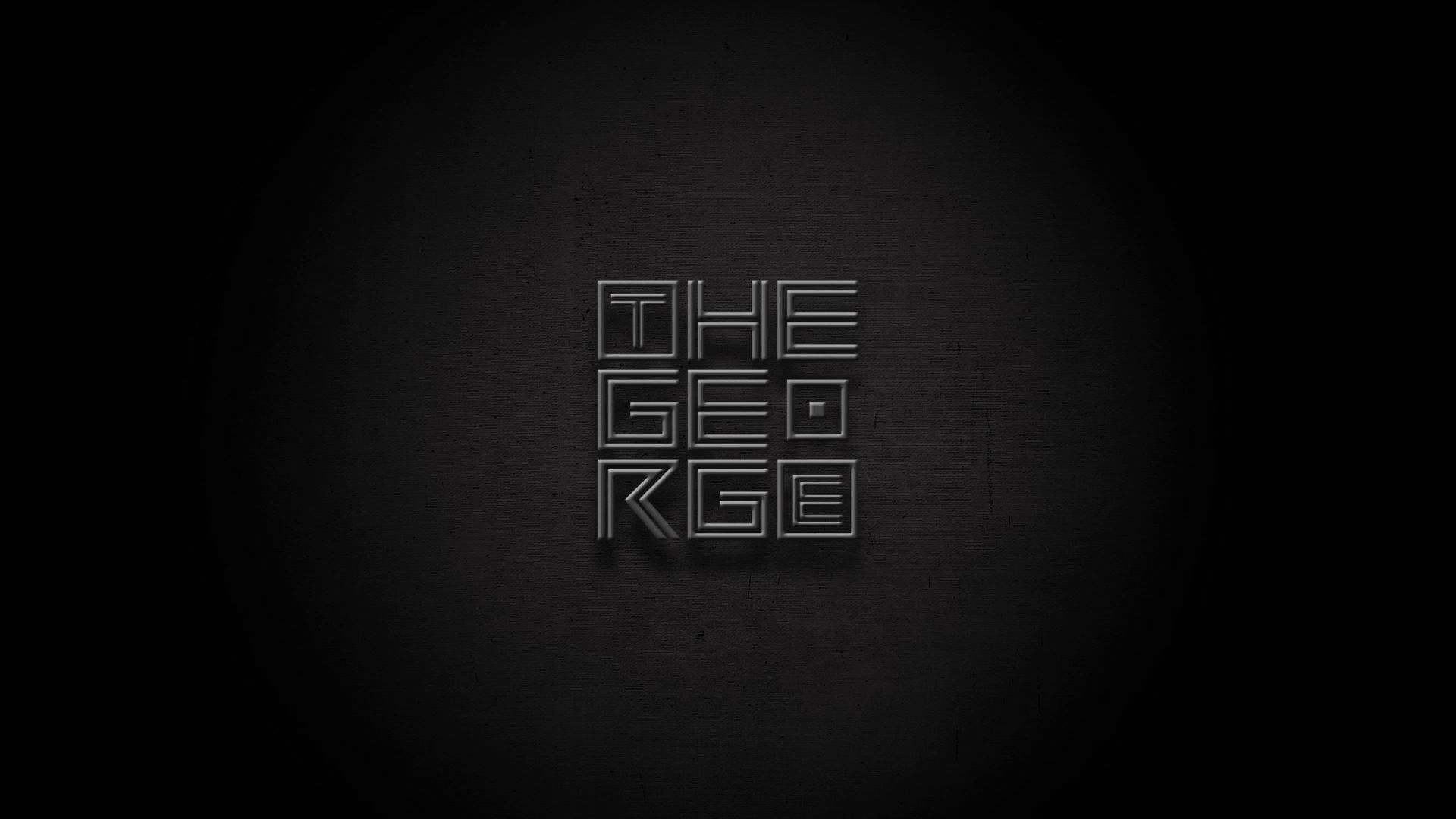Product Design
Inflow is a design platform built to help startups, small businesses, and agencies get high-quality designs faster. It offers both preset and custom creative services (like branding, logos, and UI design), while using AI to streamline project intake and reduce turnaround times.
The goal? Replace outdated agency processes with a faster, more accessible experience—without compromising creative quality.
Role
Creative Lead – UI/UX, Brand Refinement, Design Systems
Date
October 2024 – May 2025

Project Snapshot
Scope: Design of client flows, brand updates, AI-supported design process
Role: Creative Lead – UI/UX, Brand Refinement, Design Systems
Team: Me (Design), PM, Business Dev, AI advisors, CEO
Strategic Focus:
1. Make professional design more accessible to non-designers
2. Use AI to reduce intake friction and align requests with the right designer
3. Offer preset services that feel curated, not generic
Success Metrics (post-launch targets):
1. Reduced turnaround time from request to delivery
2. % of clients completing intake without support
3. Client feedback on clarity and satisfaction
The Challenge
Startups often struggle to articulate their design needs clearly, which leads to slow, expensive, and often disappointing experiences with traditional agencies.
The problem is twofold:
First, founders typically need to refine their vision through discovery sessions — a process that can take weeks.
Second, many default to prebuilt templates (e.g. Canva) but find them limiting, especially when it comes to brand nuance or custom needs.
Inflow aimed to be a platform that simplifies this experience by offering a fast, flexible design service powered by AI; helping users clarify their needs, match with the right designer, and streamline delivery without compromising on quality or human connection.
My Role
As Creative Lead, I oversaw the UX and UI design, visual direction, and refinement of Inflow’s brand system. My focus was on building a seamless product experience that could scale across different types of client needs; from startups needing a quick brand refresh to founders launching a full product.
I collaborated closely with our PM, Developer and Business Dev to translate rough business goals into flexible UX flows, and worked hands-on with AI tools to accelerate prototyping and brief generation. The goal was to not just make the platform work; but make it feel human, guided, and creatively sharp.
The Process
Due to budget constraints, we skipped traditional research and instead ran informal interviews and feedback sessions with startup founders interested in using the product. We also collaborated closely with clients’ teams to shape technical feasibility and identify flow bottlenecks early.
Research & Early Insights
User pain points were clear:
Need for speed and simplicity: Founders needed faster, simpler design solutions that didn't require the learning curve of tools like Canva or Figma.
Lack of guidance: Many didn't know what kind of design or designer they needed (branding, web, or product) and expected the platform to guide them.
Professional polish gap: Some had already used AI tools to create their own assets but felt they lacked the professional finish they needed.
From our internal team:
The PM flagged scope creep risks in scheduling and delivery logic.
The Biz Dev lead advocated for clearly defined “preset” services to appeal to less design-savvy users.
We agreed to test AI tools for intake optimization and design iteration, with the goal of speeding up decision-making.
These insights shaped how we structured both the intake and project delivery experience.
Design Decisions
Addressing User Needs Through Strategic Flows
1. User Need: Guidance and simplicity
Solution: We created two distinct user flows because our research revealed two different user types with different entry points:
1.General Flow (via “Start My Project” CTA on the Homepage and “Get Started" CTA on the Service page) Built for founders starting from scratch. Each service type (e.g., brand, product, web) features a tailored form designed to capture the right level of detail upfront — especially useful for complex, multi-part requests.
2. "Remix My Project" Flow Designed for users who had already created drafts or prototypes using AI tools. This flow allows them to easily upload and share existing materials for refinement, rather than starting over.
2. User Need : Not knowing what type of designer or design to hire
Solution: We introduced a library of 30 preset services to showcase the platform's range and adaptability: from logo design to multi-page pitch decks. Each service offered three tiers (Standard, Pro, and Premium) to accommodate different budgets and complexity needs. This helped users understand available options and make informed decisions based on their specific requirements and constraints.
3. User Need: Personal guidance and trust
Solution: Within each service page, we included the option to book a video call directly or chat with our team via Intercom, giving users a clearer, more personal entry point if they needed help scoping their request.
Prototyping & Testing
AI-Accelerated Iteration:
V0 helped us quickly build interactive low-fidelity prototypes via prompts
Claude supported the creation of content flows and onboarding copy
Early feedback showed that guided flows (vs. open-ended forms) improved completion rates and client confidence
Key Learning: Founders preferred explaining context over a call rather than filling in fields. They weren't looking to save time — they wanted to feel heard and confident in their decision.
These steps helped Inflow create a flexible, approachable, and tech-enabled design service; one that felt both human and intelligent by design.
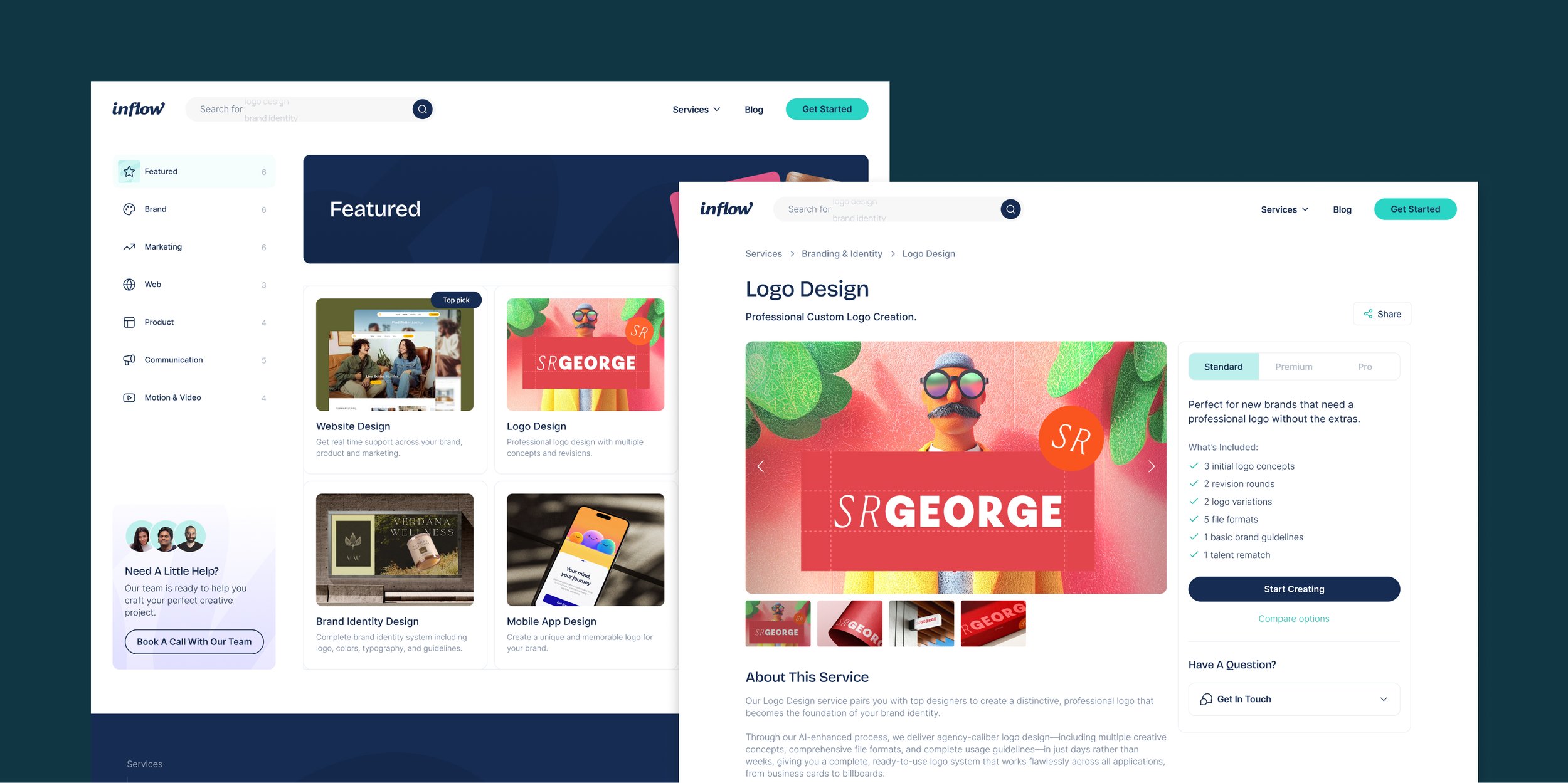
The Outcome
The MVP was fully designed and tested, and is currently awaiting development pending funding. Feedback from startup founders was instrumental in validating and refining the product direction.
We realized that speed wasn’t everything; clarity and human interaction mattered more. Our goal was to make the intake experience feel guided and personal, while keeping the workflow scalable through smart automation.
What we learned:
❌ Service-based forms led to friction
Each service (e.g., brand identity, web design) had its own detailed form to ensure the designer received all necessary information upfront. While this made handoffs easier internally, users reported that the forms were tedious and overwhelming.
✅ Replaced lengthy forms with simplified flow + human follow-up
After rounds of feedback, we learned that most founders preferred to explain the extra context over a call rather than filling in fields. They weren’t looking to save time — they just wanted to feel heard. We consolidated the forms and introduced a call step post-submission, which made the process feel more human and significantly improved clarity.
✅ Key Design Trade-off: Human Touch vs. Full Automation
While we could have built a fully automated intake system, user testing revealed that founders preferred the option to speak with our team directly. We sacrificed operational efficiency (automated forms require 0 human hours vs. 30-minute calls) because we learned that for high-stakes brand decisions, users valued the confidence that comes from human validation. This trade-off resulted in higher completion rates and user satisfaction, even though it required more resources per project.
✅Added video call scheduling as an alternative to filling out long forms.
✅ AI as backend accelerator
Claude helped turn messy briefs into structured ones; V0 enabled real-time prototype iteration. But AI worked best behind the scenes — the trust came from real human contact.
✅ Clients valued flexibility in services
Offering both preset and custom service options was a hit. It allowed clients at different stages and budgets to engage on their own terms. 60% of testers said this variety helped them take action faster.
✅ Streamlined workflows cut delivery timelines in half
Thanks to our workflows — supported by AI-assisted briefs, leaner forms, and real-time prototyping — we were able to deliver design services about 50% faster than traditional agencies. For instance, we could deliver brand identity designs in 3 weeks while agencies took 6 on average. Another example is website design projects which we managed to drop from 12 to 7 weeks thanks to AI prototyping.
Projected KPIs (pre-launch):
70% improvement in onboarding satisfaction (based on feedback from test users compared to traditional agency intake processes)
50% faster turnaround time from request to first concept delivery (6→3 weeks for brand identity, 12→7 weeks for websites)
35% decrease in drop-off rate during intake process due to simplified form logic and option for human contact
The biggest takeaway:
AI made us faster — but it was human insight that made it work.
Ready to see the results?

Where AI Shined Most
AI wasn't just part of the pitch — it helped shape how we worked.
Claude supported the early structure of user flows and brief generation. It helped translate vague client inputs into something designers could act on quickly.
V0 enabled rapid prototyping through prompt-driven iterations. We could test layout changes and flow updates in real time — with less friction and more experimentation.
For visuals, tools like MidJourney and Runway gave us a fast way to generate presentation imagery and branded mockups, bridging creative direction with delivery.
+30 Design services
Inflow offers a diverse range of design services across seven core categories to meet the unique needs of their clients. Their services span Brand, Marketing, Web, Product, Communication, and Motion & Video design, each with three customizable tiers: Standard, Premium, and Pro.
Whether you're looking for a complete brand identity, a sleek e-commerce website, a motion graphic for your latest ad, or a fully developed product design system, Inflow provides tailored solutions to help businesses at every stage. Each service is designed to offer flexibility, with options that scale based on complexity and budget, ensuring the best fit for startups, growing businesses, and established brands alike.
